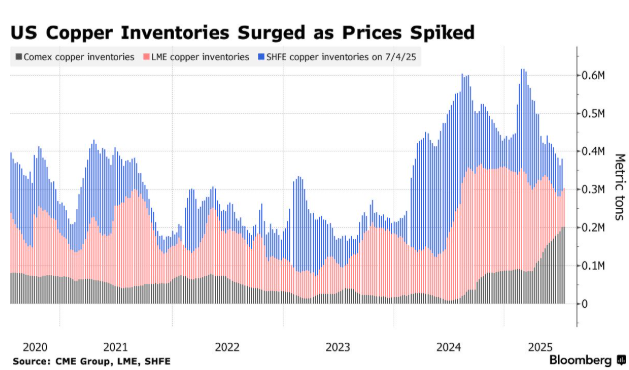US President Donald Trump announced a higher-than-expected 50% tariff on copper imports, which brought new chaos to the metal market, causing US futures prices to hit record highs and global benchmark prices to fall.
The proposed tax marks the latest twist in a tumultuous period for industrial commodity markets as the US leader aims to encourage more domestic mining and smelting. He has already raised tariffs on steel and aluminium imports and is investigating the flow of a variety of other metals.
Since Trump first announced the possibility of imposing tariffs on copper in February this year, global traders have exported a record amount of copper to the United States in an attempt to beat the implementation of the tariffs. This 50% tariff, which is stricter than expected and may be implemented within weeks, signals the end of such trade.
Citigroup analysts wrote in a report: “This is a watershed moment for the copper market in 2025, as the upcoming tariffs will suddenly close the window for further large-scale copper exports to the United States.”
The real-time price movements in New York and London reflect market expectations that the US market will tighten, but supplies in other regions will be more abundant. After Trump’s speech, the contract prices on the New York Mercantile Exchange (COMEX) soared to an unprecedented high, with a 25% premium over the global benchmark London Metal Exchange (LME) prices.
On Tuesday, copper prices on the New York Mercantile Exchange (Comex) rose by as much as 17%, setting a record for the biggest one-day increase and hitting a new high. In early trading on Wednesday, copper prices fell by more than 4% at one point. Copper prices on the London Metal Exchange (LME) dropped by 2.4% when trading opened on Wednesday. As of 10:34 a.m. Singapore time, copper prices were down 0.7% to $9,722 per ton.
“An increase in tariffs is a negative factor for copper prices on the London Metal Exchange in the short term,” said Zhao Yongcheng, chief analyst for the Chinese copper market at Benchmark Mineral Intelligence. “We expect copper prices to remain volatile before the tariffs take effect and then could see a significant drop.”
Trump’s order came as copper demand is expected to surge in the next decade, with data centers, automakers, power companies and other businesses scouring the world for the metal. The amount of copper needed to transform power and transportation systems to use renewable energy will far exceed the supply that copper producers have currently committed to.
Since Trump ordered the US Department of Commerce to conduct a review under Section 232 of the Trade Expansion Act in February this year, the global copper industry has been preparing for these tariffs. At that time, Trump ordered the US Department of Commerce to clarify the reasons for imposing these tariffs on the grounds of national security. These plans have been strongly opposed by manufacturers that rely heavily on imports.
For months, copper prices in New York have been rising as buyers rush to stockpile before tariffs take effect. In the process, input costs for US manufacturers have soared, far exceeding what their competitors pay in other parts of the world. On Tuesday, the gap reached an unprecedented level, with copper futures on the Comex in New York surging to a 25% premium over the global benchmark price set in London.
US copper buyers have warned of the long-term threat posed by tariffs, saying they could undermine Trump’s core goal of reviving manufacturing and challenging China’s industrial might.
A representative of Southwire Company LLC, the largest copper importer in the United States, stated in a written opinion submitted to the US Department of Commerce in April: “Any restrictions on the import of cathode copper into the United States will only divert copper supplies to China.” The US Department of Commerce has been investigating at the request of Trump whether to impose tariffs.
Meanwhile, US copper producers will face a severe supply shortage, especially in the short and medium term, as the growth rate of US copper production cannot be fast enough to fill the supply gap.
These warnings seem to have fallen on deaf ears. US Commerce Secretary Howard Lutnick told CNBC on Tuesday that the investigation is over and it is now up to Trump to decide what kind of taxes to impose.
For manufacturers, one consolation is that there is currently an abundant supply of copper available for purchase on the US coast – even though the price is indeed staggering. To seize the opportunity of the soaring price, traders have been shipping record amounts of copper to the US, and the copper inventory in the warehouses regulated by the New York Mercantile Exchange (Comex) has now exceeded the total inventory in the warehouses regulated by the London Metal Exchange (LME) and the Shanghai Futures Exchange.



